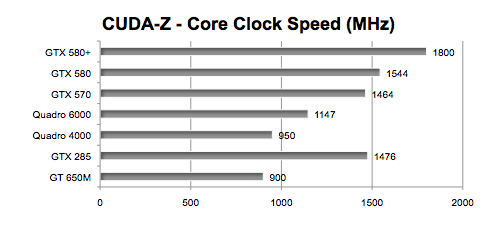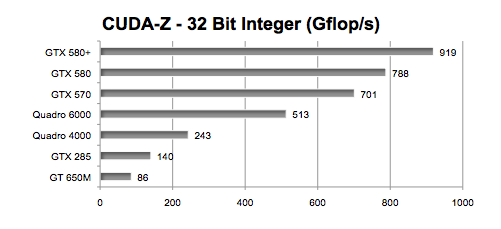SHOOTOUT: CUDA-Z reveals the potential
of the CUDA compatible GPUs
for the Mac Pro
Originally posted Thursday, September 6th, 2012, by rob-ART morgan, mad scientist
Corrected the Memory Speed of the Quadro 6000 on September 7th.
Corrected the Double Precision Floating Point graph on September 7th.
Our continued probing of NVIDIA GPU performance is inspired by Adobe's efforts to utilize CUDA compatible GPUs to accelerate functions in After Effects CS6 and Premiere Pro CS6. Though we prefer real world testing, we could not resist using a CUDA GPU benchmarking tool, CUDA-Z. (We ran version 0.6.133 - you can download it from HERE.) It's not new but it is a rarity in that it gives you core capabilities and performance and memory size and bandwidth -- data usually only available to Windows PC users.
As you saw in our article on 'divergent' GPUs, there are exciting new high-end GPU options for the 'aging' Mac Pro -- so many that it can be hard to choose one. On this page we strive to give you a sense of how various NVIDIA GPUs compare in raw speed potential.
CORE CLOCK SPEED (HIGHEST number equals fastest in Megahertz).

NUMBER OF CUDA CORES (Multi-Processors * Warp Size) HIGHEST number indicates the most.

TOTAL VIDEO MEMORY (HIGHEST number equals the most in Megabytes)

MEMORY COPY SPEED FROM HOST TO DEVICE (HIGHEST number equals fastest in Megabytes per second.)

SINGLE PRECISION FLOATING POINT COMPUTATIONS (HIGHEST number equals fastest in Gigaflops per second.)

DOUBLE PRECISION FLOATING POINT COMPUTATIONS (HIGHEST number equals fastest in Gigaflops per second.)

INTEGER (32 bit) COMPUTATIONS (HIGHEST number equals fastest in Gigaflops per second.)

GRAPH LEGEND
GTX 580+ = NVIDIA "Classified" GTX 580 GPU (3 power feeds) **
GTX 580 = NVIDIA eVGA GeForce GTX 580 GPU (2 power feeds) **
GTX 570 = NVIDIA GeForce GTX 570 GPU (2 power feeds) **
Quadro 6000 = NVIDIA Quadro 6000 GPU (1 eight pin or 2 six pin power feeds) **
Quadro 4000 = NVIDIA Quadro 4000 GPU (1 power feed)
GTX285 = NVIDIA GeForce GTX 285 GPU (2 power feeds)
GT650M = NVIDIA GeForce GT 650M GPU (built-in Retina MacBook Pro)
The first six GPUs are installed in a 'mid 2010' Mac Pro 3.33GHz Hex-Core. The seventh comes with the 'mid 2012' Retina MacBook Pro 2.7GHz Quad-Core i7. Both Macs were running OS X Mountain Lion 10.8.1.
***Both GeForce GTX 580s, the GeForce GTX 570, and Quadro 6000 were loaned to us by MacVidCards.
INSIGHTS
When you compare performance to megahertz, there is not always a correlation. Case in point is the GeForce GTX 285 compared to the GTX 570. Ditto for number of multi-processors.
The single precision floating point and integer graphs are good predictors of real world performance with most applications. An exception would be the few apps that use double precision floating point computations such as Maya and AutoCAD. Note how well the Quadro 6000 does versus all the GeForce GPUs.
The AMD GPUs like the Radeon HD 5770 and 5870 are missing from the graphs since they do not support CUDA. There may be some Windows PC utilities that provide similar performance info for those GPUs.